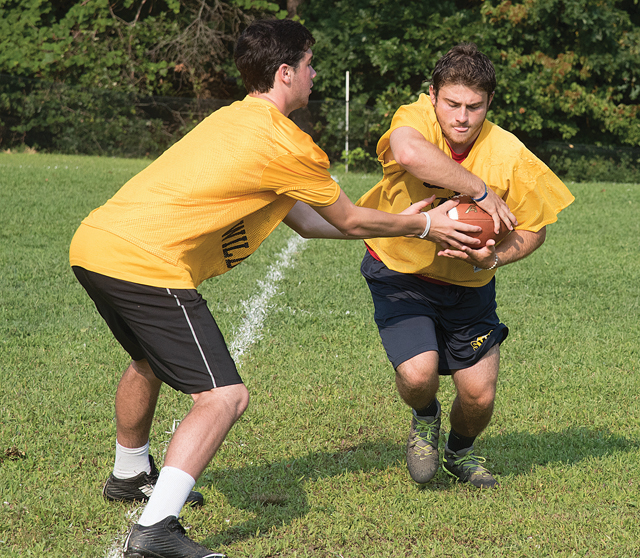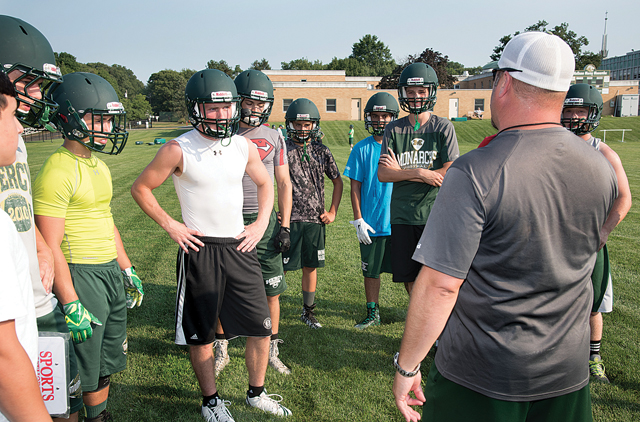Football: Training camp is a sprint to the starting line

It’s an age-old rite of summer. When the dog days of August arrive, out come the helmets and the pads, the blocking sleds, the big tires, the blocking dummies, the stopwatches, the agility cones and the agility ladders. For high school football players and coaches, it’s the unofficial start of fall.
It’s hot, grimy work in humid weather under a relentless beating sun, with coaches, sounding like Marine drill sergeants, yelling and pushing players who toil through grueling conditioning work. Along with all the hitting and the running, there is a lot of learning going on. A lot is at stake. Players are competing for rosters spots and starting positions. Teams are preparing for the challenges of a new season.
Preseason training camp is here.
Many see the preseason period as the most important part of the year for a team because training camp is where the groundwork is laid for the upcoming season.
“Everything starts here,” Bishop McGann-Mercy’s coach, Jeff Doroski, said. He said: “I tell my guys, for me, it’s like my version of Christmas. I get excited about the work that these guys put in during the course of the year after the conclusion of the [previous] season, and then obviously throughout the summer.”
The first official day of preseason practice for high school football teams throughout New York State was Aug. 17. For some coaches, it may feel like they are now “on the clock,” trying to squeeze as much work into those practices and scrimmages as they can before the start of the season. Three local teams — Greenport/Southold/Mattituck, McGann-Mercy and Shoreham-Wading River — start their season early, on Sept. 4, just 18 days after training camp started.
New York State Public High School Athletic Association rules mandate that the first two days of practice must be noncontact, without the use of protective equipment (although helmets may be worn) and mechanical blocking devises. For the next three days, players are permitted to wear shoulder pads. Blocking dummies, sleds and similar devices are allowed. Tackling drills, team scrimmaging and running full contact plays are not, though. The following six days consist of contact practice with full protective equipment and the use of all training devises. Full contact and team scrimmaging is permitted.
Because practices are prohibited in the mid-day summer sun, teams typically run two-a-day practices starting at 7 a.m. and 5 p.m.
Some players take a mixed view of training camp, sort of like a necessary evil.
Asked what goes through his mind when he hears the words “training camp,” Dominick Panetta, a senior tight end and strong safety for Greenport/Southold/Mattituck, answered, “A lot of work.”
Players are best advised to come into camp in shape from off-season work. Training camp is hard enough, even for those who had participated in off-season training programs and worked out on their own.
“It gets pretty intense,” said Chris Rosati, a senior strong safety and running back for defending Long Island Class IV champion Shoreham-Wading River.
McGann-Mercy senior lineman Brian Boden acknowledged, “The two-a-days are a little rough.”

For the Riverhead Blue Waves, it has been especially rough. At the conclusion of their first preseason practice, one of their players, Nikolas Visco, collapsed from an apparent heat stroke. The junior lineman was listed in critical condition at Stony Brook Medicine, according to a spokeswoman.
Since then, Riverhead coaches have been visiting Visco, who has been kept sedated, and community members have offered their prayers and thoughts for the fallen player. Coach Leif Shay has urged people to post video messages for Visco on the team’s Facebook page.
“It’s a hard time for all of us right now,” said Shay.
For players, it is important to stay hydrated, listen to their coaches and hustle at all times.
Rules are an important part of training camp. Coaches can be sticklers to them. It all comes with the disciplined approach.
Among the rules put in place at Riverhead High School is no cutting corners. Several years ago, a reporter walking with Shay made the mistake of walking across a corner of a field instead of around it. Shay stopped dead in his tracks, looked back at the corner and waited until the reporter tracked back and walked around the corner.
During a practice a couple of weeks ago, Shay, from a distance, caught at least one of his players sitting down while the team was split into groups doing drills. Shay immediately halted practice, reprimanded the offending party and had the entire team do a punishment drill.
“Most important, I think, really is the working hard part, and just working hard, busting their tails out here, every minute, every second, every hour that we’re out here,” Tyrese Kerr, a senior who plays halfback and defensive end for the Blue Waves, said after that practice. “The best advice I can give to young players is to watch the next guy ahead of them and work just as hard as that guy ahead of you.”
Shay said training camp “sets the tone for the season as far as your work ethic.” He said it is important for young players to “learn how to work hard, learn how to be disciplined and learn how to make sacrifices. I think those are the things that football teaches, and if we do those things I think we’ll be alright.”
Jack Pavelchak, a senior wide receiver and outside linebacker for McGann-Mercy, had training camp in mind when he appeared at the second practice session on the first day wearing a fresh-cut Mohawk hairstyle, along with a Superman T-shirt. Pavelchak said he likes the way the Mohawk looks, but it also has a practical side to it: It keeps him cooler during the hot days of training camp.

But training camp is as much mental as physical. It’s a time when players are learning plays and some players are learning new positions.
“It’s hot, it’s summer, we’re away from home,” Shoreham-Wading River coach Matt Millheiser said. “Kids have to give up odd jobs and vacations and other things that they want to do, but it’s important, like I said, to figure out where everybody’s going, what are the strengths of the team, what we want to emphasize this year so that when we get to the first week of the season we hit the ground running.”
It’s a time for ironing out the wrinkles and fine-tuning details.
In Greenport, the Porters had a new head coach, Mike Buck, who brought with him a new playbook and a new way of calling plays.
“Preseason is very important, especially when you have a new coach coming in because you have a whole new playbook, you have a lot to learn and you only have so much time to do it,” said Tristin Ireland, a senior running back and linebacker.
But then last week came the stunning news that Buck had resigned after not getting a teaching job in Greenport. The athletic director, Jim Caliendo, said he has recommended that Jack Martilotta, the Porters’ former head coach who had stepped aside to become their defensive coordinator, once again return to his former role as head coach.
Martilotta said training camp is an adjustment period for players, including younger ones who are learning that what worked for them at lower levels of football may not work at the varsity level.
“This is what builds your team,” Martilotta said. “I mean, if we can’t get it accomplished here, it’s going to be tough to pull it off later in the year. There’s no distractions. The kids don’t have to go to classes. This is really what they have to worry about for two or three weeks.”
Ireland said this is the 13th preseason he has been involved in going back to his days in youth football. “It’s an exciting time,” he said.
Conditioning takes on added importance at smaller schools where small roster sizes mean more players play on both sides of the ball who don’t have the luxury of coming off the field much for a breather.
McGann-Mercy is one of them. Early in training camp the Monarchs had only 24 varsity players.
“Our numbers are small, and that’s traditionally the way it is here at Mercy,” Doroski said. “We have to be in shape. We have to be physically capable to play four quarters of football, and a number of our guys are going to play on both sides of the ball, so we have to be physically tough and we have to get mentally tough, and this is a great time to do that. Guys are tested out here in the heat.”
For younger players, it’s an opportunity to make their mark, to make a name for themselves.
Ethan Wiederkehr, junior tight end and defensive end, expects to see some good things from some of his younger teammates. Following the Wildcats’ morning practice on Day 2, he said, “Training camp now is a little slow with no equipment, but when we get equipment on, things are going to pick up and those younger kids are going to get to step up and we’re going to have some playmakers.”
While NFL training camps have changed in recent years with less hitting and two-a-day practices a thing of the past, Martilotta was asked if high school training camps had changed since he played for the Porters.
“I remember it being hotter, but I’m not sure if that’s accurate or not,” he said. “I don’t think football’s changed all that much since my grandfather played. It’s the same thing. … It’s sacrifice. It’s playing as a team. It’s executing.”
And some drudgery, to be sure. For coaches, the start of training camp also involves all sorts of logistics that needed to be attended to beyond the field, such as physicals, paper work and the distribution of equipment. Coaches and players alike hope it all leads to playoffs, championships and glory down the road.
“Where else would you rather be right now?” Martilotta said. “This is it.”








